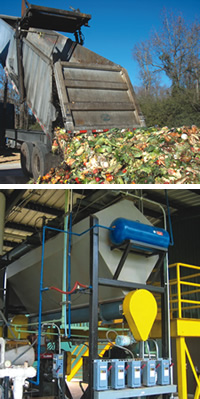 BioCycle August 2011, Vol. 52, No. 8, p. 53
BioCycle August 2011, Vol. 52, No. 8, p. 53
With growing demand for food waste management, a handful of project developers – using the build, own, operate model – have secured investors, feedstocks and power purchase agreements and are constructing facilities. Part II
Diane Greer
AN emerging group of commercial companies see a viable business opportunity in North America around building, owning and operating larger scale anaerobic digestion (AD) facilities to process mixed organic waste streams. In some instances, the projects being proposed and constructed only include anaerobic digester operations. In others, there is a combination of digestion with back-end composting. In all cases, these companies have secured feedstock supply and markets for the biogas.
Harvest Power, based in Waltham, Massachusetts, is an example of a developer that is combining AD and composting. The company is constructing an anaerobic digestion facility at its existing 30,000-tons/year composting operation outside of Vancouver in Richmond, British Columbia. When completed in late 2011 the facility will process 50,000 tons of food waste and yard trimmings annually in high solid anaerobic digesters (HSAD) to produce 2.5-MW of combined heat and power.
Germany’s GICON Bioenergie GmbH is working with Harvest Power on the design, construction and start-up of the plant. The two companies formed a partnership in late 2010 that gives Harvest Power exclusive right and patent ownership of GICON’s HSAD technology in North America. GICON will handle plant engineering.
The project is integral to Harvest Power’s strategy of maximizing the value of organic waste streams by building, owning and operating facilities that integrate AD and composting to produce renewable energy and soil enhancement products. “We see a real synergy in combining anaerobic digestion facility and composting operations,” says Paul Sellew, CEO of Harvest Power. “The next ‘slug’ of organic wastes available for processing is going to be a lot of pre and postconsumer food waste. In states with renewable energy incentives there are opportunities to build AD infrastructure to make energy out of these materials. That needs to be integrated with composting because the end product coming out of the digester needs to be managed.”
 Under the company’s business model, projects must be sited in states with renewable portfolio standards (RPS) to insure a good price for the energy. Locations are selected where the firm can procure the rights and aggregate organic materials from local markets. Revenues are earned from tipping fees and sale of the renewable energy and by-products from the process, which may require further processing by composting or pelletization. “You need to have revenue from all three sources and you need to maximize it,” Sellew says.
Under the company’s business model, projects must be sited in states with renewable portfolio standards (RPS) to insure a good price for the energy. Locations are selected where the firm can procure the rights and aggregate organic materials from local markets. Revenues are earned from tipping fees and sale of the renewable energy and by-products from the process, which may require further processing by composting or pelletization. “You need to have revenue from all three sources and you need to maximize it,” Sellew says.
Critical to the model is a project team with expertise in feedstock procurement, the selection, building and operation of the conversion technologies and agricultural and horticultural end product markets. “It is difficult and complicated,” he adds, “which is a reason why you aren’t seeing more facilities despite all the interest.”
Harvest Power is developing a second anaerobic digestion facility in London, Ontario. The plant will process 80,000 tons of agricultural and food processing wastes in low-solids digesters to produce 5.7-MW of power. Solids from the process will be sold as pelletized fertilizer.
The firm recently raised $57.7 million in a series B financing. Major investors in the company include Kleiner Perkins Caufield & Byers, Generation Investment Management, Munich Venture Partners and Waste Management. “We are bullish and we are investing,” Sellew says. “We have a lot of other facilities in our pipeline. From our standpoint we see opportunities, but we also realize you have to execute if you are going to be successful.”
PERSISTENCE PAYS
After five years of development work, NOVI Energy in Novi, Michigan broke ground in June on the $22-million Fremont Community Digester (FCD) project in the western Michigan town of Fremont. NOVI is developing and will manage the project, converting 100,000 tons of organic wastes into biogas that will fuel GE Jenbacher engines with 3-MW of generating capacity. Electricity will be sold to Consumer Energy, a Michigan utility, under a long-term power purchase agreement (PPA). Facility completion is slated for summer 2012.

INDUS Energy, LLC, a Bingham Farms, Michigan-based investment group, is the project’s majority owner. NE BioFuels, a NOVI subsidiary, and North Central Cooperative (NCC) of Wabash, Indiana, are minority owners. FCD will earn tipping fees from processing local pharmaceutical, food processing and biofuel residuals and agricultural wastes, including some manure. Feedstock contracts are in place with Fremont-based Gerber Products Co. and 15 other companies. Digestate will be processed into a liquid fertilizer and compost that NCC will market to regional agricultural business.
“This is a real opportunity for food processing companies in western Michigan,” says Rob Zeldenrust of NCC. “Many of these food processors have been struggling to meet BOD requirements. Some have wastewater treatment facilities that are maxed out, others are paying to have it landfilled or land applied.” He adds that NCC, which has a cooperative in Fremont, wanted to get involved in the digester project because it supplies fertilizer to the growers who in turn supply the food processors. “The liquid digestate is a high quality form of plant food, and it will be manufactured right here in Fremont.”
The complete mix digester complex will consist of three independent digester plants capable of stepping up from mesophilic to thermophilic temperatures on demand. Each digester can be optimized based on the specific waste streams being handled. “Because we have these three large digester tanks we have the capacity to take a wide variety of wastes,” says Anand Gangadharan, CEO of NOVI Energy. The diversity of feedstock allows the firm to mitigate supplier risks, providing a level of business certainty. “That is appreciated by our financial institutions and our partners,” he adds.
Obtaining permits for the 30 different waste streams that can be processed by the facility was challenging. “It took time for the various government agencies to understand what we were doing and the various wastes we were bringing in,” Gangadharan notes. “There was a lot of education and communication.”
Obtaining financing required the team to identify and mitigate the risks associated with the project. “Every single piece of equipment, all the services, feedstock contracts, output contracts, everything has been locked down under long-term contracts,” he explains. The project has all its permits and Engineering Procurement and Construction (EPC) contracts are in place with 100 percent payment and performance bonds.
Securing the financing took a lot of perseverance, he adds. “I’ve spoken to over 200 investment and private equity firms.” For many potential investors the project’s rate of return was not high enough. NOVI ultimately found a savvy group of private equity investors that liked the team, the contracts and the set-up. “They wanted to get in early and asked for options to invest in future projects,” Gangadharan says. “They are counting on us to become more efficient and improve our returns over time.”
Comerica Bank is providing debt financing with the backing of a debt guaranty from the U.S. Department of Agriculture under its 9003 Biorefinery Assistance Program. The project was awarded over $2 million by the Michigan Public Service Commission under an energy efficiency competition and will also take advantage of the U.S. Treasury 1603 grant program that covers 30 percent of the capital costs if construction gets underway before the end of 2011.
OPTIMAL ENVIRONMENTS
Tony Callendrello, COO of NEO Energy in Portsmouth, New Hampshire, is developing an anaerobic digestion facility in Haverhill, Massachusetts, that will convert 50,000 tons of food waste annually into 2.8-MW of electricity. When Callendrello, an energy project developer, became interested in the AD sector he traveled to Germany and Austria to investigate technologies and tour facilities. Upon his return, he began to identify optimal environments for digester projects. “New England, and Massachusetts in particular, is one of those areas,” he says.

Massachusetts has an RPS and a fairly lucrative REC (renewable energy credit) market and is aggressively pursuing food waste recycling. A draft solid waste master plan by the Massachusetts Department of Environmental Protection proposes a ban on disposal of commercial and institutional food waste in landfills or incinerators starting in 2014. “They will need recycling capacity for food waste,” Callendrello says. The state is also fast tracking a process to clarify regulations for developers seeking to permit an AD facility.
NEO selected Haverhill as the location for its first facility. Haverhill is home to a cluster of food manufacturers. “The City Fathers see the local economic benefit of a waste recycling facility, both for keeping their existing businesses economically viable and for potentially attracting new food processors to the area,” Callendrello explains. When completed in 2012, the Haverhill Organic Energy (HOE) facility will include a drying and pelleting plant to produce fertilizer from the digestate.
Contracting for the large amounts of feedstock required by the facility has been challenging. “In the waste business most people are used to fairly short contracts and are a little bit leery about entering into a contractual obligation for a project that has not started construction, much less one that will take a year to construct,” he says. He is seeing significant interest from forward thinking supermarket chains and big box stores with food waste recycling as an integral part of their sustainability goals.
In Massachusetts, utilities use an auction process to purchase renewable energy to satisfy the state’s RPS. “Eighty percent of the criteria for selecting a potential renewable provider is cost,” Callendrello explains. Anaerobic digestion, which must compete with wind and other renewables, is not the lowest cost on a pure dollars per MWh basis. “That’s a challenge,” he adds. “We are trying to get creative in how we do our contracts so the utilities can see the value of potential greenhouse gas or carbon offsets and maybe some of the other values that are unique to AD plants compared to some other renewable sources.”
Reynolds, Inc. in Orleans, Indiana, in partnership with Austria-based ENTEC Biogas, will design and install the ENTEC biogas anaerobic digestion system and provide an EPC for the project. The EPC makes project financing a lot easier, Callendrello says. Equity funding will be supplied by NEO’s parent company, BayHoldings, a merchant energy company with renewable power, natural gas and oil production assets. The project has been allocated tax-exempt bonds by the Massachusetts State Development Authority and will apply for U.S. Treasury1603 grants. NEO is ready to move forward with a number of other projects as soon as HOE is completed.
CHANGING BUSINESS PLANS
When Anwar Shereef took over controlling interest of Orbit Energy in 2006, he changed its business model. The company had targeted middle-income countries and rapidly developing Asian countries for the sale of its high solids anaerobic digestion (HSAD) technology. Developed by DOE’s National Renewable Energy Laboratory, the technology employs a proprietary thermophilic bacteria that can handle high organic loading rates. Orbit obtained the international license for the HSAD in the late 1990s.

Instead of selling the technology to others, Shareef, now Orbit’s CEO, decided to pursue a build, own, operate business model in the U.S. where revenues are generated by long-term power contracts and sale of the digestate. These changes in the business plan were a response to changes in the U.S. market. Many states have adopted RPS standards, which increased the price received for power generated by digester facilities. Interest in diverting food waste streams was another factor. “Segregated food waste is starting to become more prevalent,” Shareef says. “Many states have a strong interest in segregating food waste if they had a destination for the material.”
Orbit’s sales pitch is helped by an 8-year track record running a pilot HSAD facility in Clinton, North Carolina. The 12-tons/day plant is comprised of two digesters that can process feedstock with up to 45 percent solids, such as food waste, yard trimmings, cardboard, animal waste and agricultural residues. Demonstration grants enabled extensive feedstock testing. “Results of all the studies are very positive,” Shareef says.

Orbit is planning to build its first commercial scale 120-tons/day HSAD facility at the Central Landfill in Johnston, Rhode Island. The $15-million plant will process preconsumer food waste from grocery stores, restaurants and institutional cafeterias in two HSAD digesters. Biogas from the plant will drive two generators producing 3-MW of electricity. The power will be sold to National Grid under a 15-year PPA. The digeseter is scheduled to start operating in 2013.
Digestate exiting the HSAD contains low moisture levels, which allows the material to be dried to compost-consistency using heat captured from the engines generating electricity. (Typically digestate is separated into a liquid and solid stream. With this process there is no liquid stream.) “Our plan is to sell the material in bulk to other composters,” Shareef explains.
The PPA is awaiting approval by the Public Utilities Commission in Rhode Island. Shareef hopes to have the environmental permits for the site by the end of the year. Feedstock contracts are also in the works. The company has received two interim term sheets for the debt piece of the project (i.e., funding offer from the capital provider with amount of investment and conditions). Work is underway to finalize the equity piece. The company is currently funded through about 60 private investors.
Diane Greer is a Contributing Editor to BioCycle.
August 16, 2011 | General










